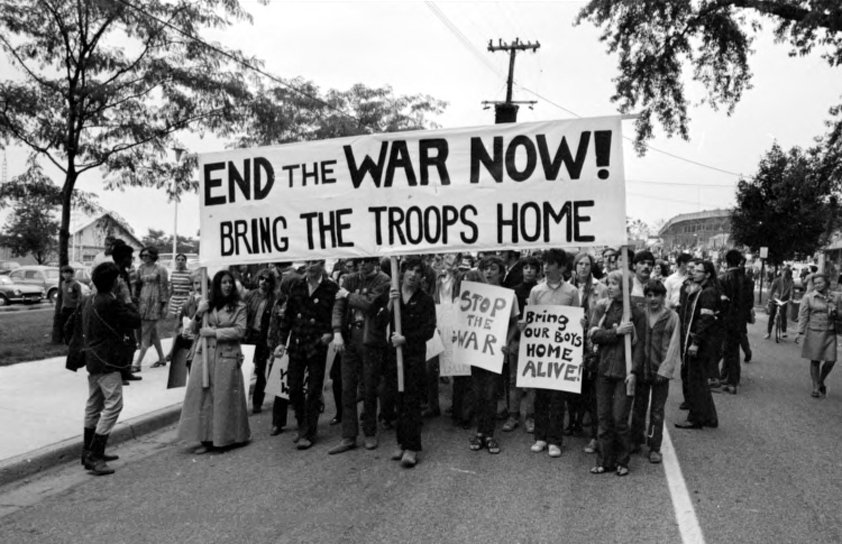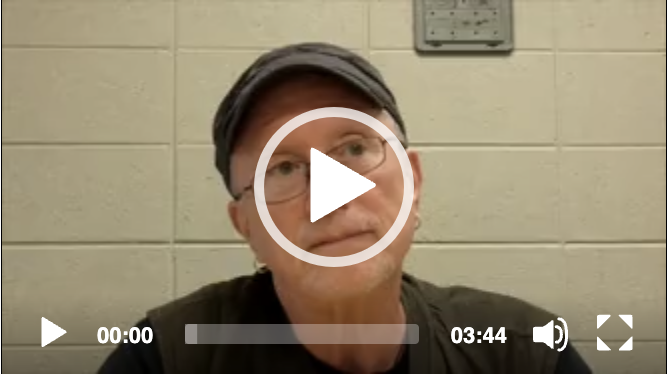Vietnam War Protests
Opposition to the Vietnam War began nearly as soon as the conflict began, with Quaker anti-war demonstrations in the 1950s and 60s. Protests didn’t gain much national attention until the mid-1960s when the draft began to come into effect. Many Americans had no interest in fighting, and with a draft system that favored white, middle-class men and forced young African American men to serve at a disproportionally higher rate than any other demographic. Aside from the draft, protests of the war were also due to the immoral conduct of the war. Public opinion on the war began to shift as the war dragged on with no end in sight, government cracking down on war protesting and seeing coverage of the horrible things occurring overseas.
All of these things culminated in the first national demonstration against the war, in 1967 over 35 thousand people rallied to Washington DC for a day of peaceful protest. However, as the day continued the peaceful mood of the crowd began shift, and in the evening the group headed for the Pentagon. The crowd stormed the fences and made their way inside the grounds where nearly 5 thousand troop rushed outside equipped with rifles and bayonets, a full-scale riot then erupted. The legacy of this massive protest caused many similar demonstrations to occur across the country and in 1969, hundreds of thousands of Americans took part in two “national moratoriums” that were critical to ending involvement in the war. The anti-war movement of the 1960s was one of the largest in the country’s history and led the ending of the Vietnam War. Many people argue that U.S. involvement was necessary to bring the conflict to an end, but a racially biased draft, campaigns that made no headway, and a reckless loss of human life prove that the cost of human life is always too high.
Ukraine, Palestine and Anti-War Protests
In early 2022, an unprecedented escalation took place; Russian President Vladimir Putin ordered his army to invade Kyiv, the capital city of Ukraine. This was a major shock to the world, because while this was just the latest escalation in an eight-year conflict, the devastating battle lasted nearly two months and left tens of thousands of people dead. In 2014, Russia had annexed a part of Ukraine, a country that had been a part of the former Soviet Union before its collapse. The following hostilities have been in the background for the last eight years, until Russia’s sudden offensive into Ukraine’s capital. Both domestic and international responses were in support of Ukraine in this war. NATO and the United Nations have provided aid for Ukraine, and on top of that, the U.S. has personally offered support as well. Since the first attack, Ukraine has been fighting off Russian forces with help from the UN and NATO. Russia still tries to push for advances in territory and does not look like it will be stopping anytime soon as Ukraine is adamant on keeping independence. While the conflict continues into 2024, it is clear that things are beginning to fall apart for Russia; global opinion has turned against them, and despite having superior numbers, the Russian army has not been able to make much headway into Ukraine.
Despite overwhelming support for Ukraine, protest is still necessary. Massive public outcry could be considered the kick for UN and NATO forces to begin to provide aid to Ukraine. The call to action worked, as by late March of 2022, aid was already being supplied to Ukraine, only a few weeks after the initial attacks. People did not stop there through, conservatives seemed to express support for Russia, and would lead to disturbing pro-Putin remarks at conservative political rallies. This caused people to double their efforts in providing support for Ukraine, for most, supporting Russia was out of the question as there was no reason to support an invading force. Thankfully, support for Ukraine remains strong. While other things have pushed the war into the background, aid is still being delivered to Ukraine and the fight goes on.
Most recently, is the atrocities occurring in the Gaza Strip, a city that encompasses a majority of the nation of Palestine. In October of 2023, the terrorist group Hamas launched an attack on the neighboring nation of Israel. Estimates of the death toll are still called into question, but Israel officials say about 1,200 people were killed in this attack. This was just the latest tragedy in a nearly 70-year long history of violence between Palestine and Israel. While events are still unfolding, it is clear that Israel’s response has been far too brutal to the civilians of Gaza. Many people continuously call Israel’s actions into question, calling their tactics “collective punishment,” considered a war crime in the Geneva Conventions and it’s not unjustified to call it that. Since October, over thirty thousand civilians in Gaza have been killed, apartments and hospitals have been leveled and millions have been displaced.
A major factor people who condemn Israel’s actions bring up, is the Israeli government’s spreading of misinformation and refusal to take accountability for their actions. Often Israeli officials seem to just deny things that have been filmed and recorded, and that is something people see as an injustice. Protests in support of the people of Palestine have been constant and widespread, much like support for Ukraine, most of the people of the U.S. and Europe are in full support of ending the occupation of Palestine and call for Israeli forces to move out of Gaza. However, this conflict has a lot more nuance than Ukraine; despite Israel’s brutal retaliation, it was in response to a deadly terrorist attack, so it is justified right? Many agree, but many more disagree. While Hamas’ attack was terrible and a horrible waste of human life, it could be said it was an oppressed state lashing out at their oppressors. Prior to this attack, many people did not know that Gaza is completely cut off from the rest of the world; water, electricity, internet and trade is all controlled by Israel. People call Gaza “the world’s largest open-air prison.”
Regardless of where people stand, the death of innocent civilians is something that should be protested, and that is exactly what is happening here. The people of Gaza are unable to help themselves, and supplies are difficult to get into the city. It is common to hear what is happening in Gaza a genocide, and it rings particularly true when you step back and see how similar it is to other genocides. Protests for aid to Palestine continue to this day, and with no sign of the conflict ending, it is likely the protests will continue as well.
Soptlight Interview
The University of Michigan has been a symbol of student activism for decades and had a prominent role in the anti-war movements of the 1960s. In response to President Lyndon B. Johnson’s sudden escalation of the Vietnam War, the University of Michigan’s student organizations acted as an inspiration and a foundation for anti-war activism. Their first major demonstration involved faculty members staging a teach-in to educate students on U.S. foreign policy in Vietnam, this would eventually spread to other universities across the nation. The teach-ins began to gain not only local, but national attention as well and with the movement now in the hands of students, the anti-war tactics quickly shifted from conversation to direct action. This direct action first came in the form of a sit-in at the Selective Service Office in October 1965, which resulted in the arrest of several University of Michigan students. The efforts of the Anti-Vietnam War Movement resulted in open dialogue between students, faculty, university administrators and the government about foreign affairs issues and helped to put an end to the war overseas.
Today, undergraduate students from the University of Michigan created an exhibit that covers the events of the Anti-Vietnam War Movement; starting with origination of the New Left, in the early 1960s, it explores the tactics used by anti-war activists throughout the 1960s. The following interview is just one of nearly a dozen on the website, but we chose to highlight the interview of Bill Ayers. Ayers was a student at the University of Michigan and became an activist at the university from 1964 until 1968. He was present for the first teach-in in 1965, was arrested for a sit-in at the Ann Arbor Selective Service Office, and later became a leader of the radical group Weather Underground. He also participated in various other acts of resistance throughout his undergraduate years at UM.
Throughout Ayers’ multi-part interview, he speaks about how he grew up in a sheltered environment while growing up. After attending the University of Michigan and being present for the escalation of the Vietnam War, did he become aware of the social injustices taking place. This first four-minute clip Ayers talks about becoming active in your community and taking direct action, specifically mentioning that there comes a time where just talking about protesting isnt enough: “Don’t just have good ideas on your couch, because that’s not direct action. Non-violent means non-violent direct action, and if you’re not doing that, you’re sitting on your couch.” What Ayers is pointing out here is that while the intellectual discussion of the teach-ins at UM and other campuses were effective, there came a point where people realized talking would only get you so far.
Later on, Ayers speaks on how the Civil Rights Movement had a significant impact on the Anti-War Movement, and how much of an inspiration it was to the students at the University of Michigan. “I don’t think anybody was there in that spirit (conforming to being part of a movement just for fun) I think we were drawing on the Civil Rights Movement very heavily, both in terms of stance and in terms of tactics. “Ayers believes that the anti-war movements took a direct inspiration from the Civil Rights Movement, and he isn’t completely wrong. Many of the organized gatherings protesting the Vietnam War were reminiscent of Civil Rights rallies held only a few years prior, and even more interestingly is how the LGBT movements of the time were also taking inspiration from the very same protests. It just shows how interconnected these movements all were, taking inspiration from one another. Despite the differences in people and time, they were functionally the same when it came down to the bare essentials of the movement, justice for the people, especially the most vulnerable amongst our people.





